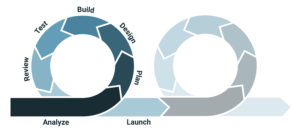Iterative and Incremental Assignments for Deeper Learning
Introduction
Iteration involves multiple cycles of building, testing, and refining products and processes (Schön, 1993). For many professionals across disciplines, iterative processes are core to the work they do. For example, engineers go through multiple iterations of creating designs, gathering feedback from users, and revising their designs as they develop their innovations. Authors iterate by incorporating multiple rounds of feedback from editorial teams as they develop their books and manuscripts. In business, companies conduct extensive market testing before rolling out new products. It is through these iterative processes—with cycles of feedback—that professionals learn how to improve their work to meet their goals.

Multiple Feedback Loops (source alamy.com)
What the Research Says
All too often, students do not receive feedback or guidance until the assignment is complete, when it’s too late to get their work back on track or apply what they have learned from their mistakes. However, research has found that feedback loops in learning are associated with gains in student performance in multiple disciplines (Hattie, 2009). A feedback loop includes an opportunity for students to not just receive feedback, but also to process and apply it to future iterations of their work. For maximum impact, feedback should serve as an interim step that guides students toward successfully completing and achieving the goals of the assignment (Ambrose, 2010).
Feedback loops can benefit the educator as well. As Sadler (1989) put it, “the only way to tell if learning results from feedback is for students to make some kind of response to complete the feedback loop.”
Feedback loops may be applied to any multi-week assignment through iterative and incremental structures. Benefits of such structures are listed below.
Benefits for students:
- Deeper learning
- Increased potential for successful, on-time assignment completion
- Reduced anxiety
- Support for self-directed learning
- Greater equity for students with less experience with the type of assignment
- Experience with authentic processes that can be transferred to the workplace
Benefits for Educators:
- Ability to identify misunderstandings early in the process
- Insights into student progress and level of learning throughout
- Opportunities to responsively scaffold the learning based on observations
- Higher rate of student success
CATLR Tips
To support learning and success for all students, major assignments can be structured to resemble processes followed by professionals in the course discipline, with low stakes interim deliverables (or performance rehearsals) that make progress visible and serve as “shared, critiquable externalizations of student knowledge” (Blumenfeld et al., 1991). Through this approach, students progressively build on and refine their work, incorporating feedback into each successive iteration. At each milestone, they receive feedback–from peers and the educator–that advance their work toward the goals.
As illustrated below, students begin with foundational pieces like plans, sketches, and rough drafts, and build from there, incorporating feedback into the more in-depth aspects of the deliverable, piece-by-piece, until the assignment is complete. NOTE: This illustration shows one iteration of each deliverable, but there could be multiple iterations, depending on the context.

Iterative and Incremental Assignment Structure
General Ideas for Deliverables
| Example Deliverables for a Video
| Example Deliverables for a Proposal
|
NOTE: There could be several iterations of each deliverable.
Strategies
Below are some strategies for effectively structuring iterative and incremental assignments and managing the work of providing feedback.
- Ensure dependencies between the parts of the assignment.
- Provide feedback in a timely fashion so that students have time to incorporate it into their next deliverable (block out time on your calendar for giving feedback).
- Adopt the mindset that feedback is a form of teaching; you may replace some instruction delivered up front with instruction that is delivered through feedback.
- Be explicit about the assignment structure and include visuals and/or checklists.
- Be explicit about assessment criteria for each interim deliverable.
- Provide feedback in a timely fashion so that students have time to incorporate it into their next deliverable (block out time on your calendar for giving feedback).
- Adopt the mindset that feedback is a form of teaching; you may replace some instruction delivered up front with instruction that is delivered through feedback.
References
Ambrose, S. A., Bridges, M. W., DiPietro, M., Lovett, M. C., & Norman, M. K. (2010). How learning works: Seven research-based principles for smart teaching (1st ed.). San Francisco: Jossey-Bass.
Blumenfeld, P., Soloway, E., Marx, R. W., Krajcik, J. S., Guzdial, M., & Palincsar, A. (1991). Motivating project-based learning: Sustaining the doing, supporting the learning. Educational Psychologist, 26, 369–398.
Hattie J. (2009). Visible learning: A synthesis of over 800 meta-analyses relating to achievement. New York, NY: Routledge.
Sadler, D.R. (1989). Formative assessment and the design of instructional systems. Instructional Science, 18(2), 119-141.
